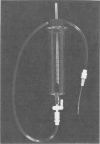Abstract
The national incidence of retained and recurrent common duct stones is between 2 and 7%. A prospective comparison of operative common duct pressure flow rates as opposed to operative cholangiography was commenced in 1968 to assay another diagnostic technique to assist in the reduction of this rather high incidence of recurrence. We are now reporting the 6-8 year follow-up data on the first 200 patients, 190 (95%) of whom were reevaluated in 1977. In our inital reports we were surprised to find that our accuracy with flow and pressure studies was 93%, not significantly different from that found with operative cholangiography (92%). The measurements of flow, resting pressure, and opening pressure in the patients with stones or strictures at the lower end of the bile duct were each significantly different from those found in normal ducts (p < 0.001). We considered normal flow to be 10 ml/min saline at 30 cm of pressure and normal intrabiliary pressure to be less than 16 cm of saline was measured through the cystic duct. To date only one individual has had to undergo reoperation for stones and another for recurrent biliary obstruction. A third individual is suspected of, but not proven, to have a retained stone. No patient who had a normal operative cholangiogram, flow and pressure studies, has had a late recurrence of stones. We have presented the specifications of a new catheter for performing flow and pressure x-ray studies, which we feel may be used to primarily evaluate the distal duct with greater accuracy and clarity. We think that this inexpensive but reliable method has an important place in biliary surgery, particularly where operative cholangiography may not be available, or, for one reason or, another, is not reliable.
Full text
PDF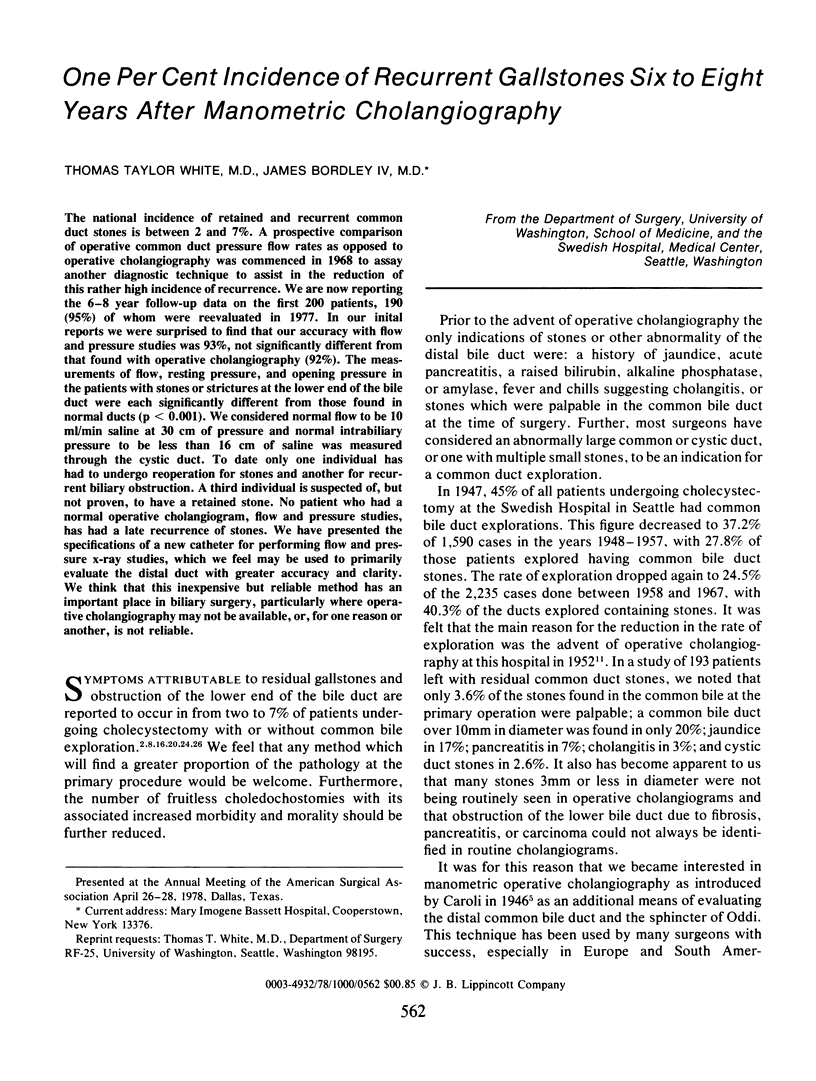
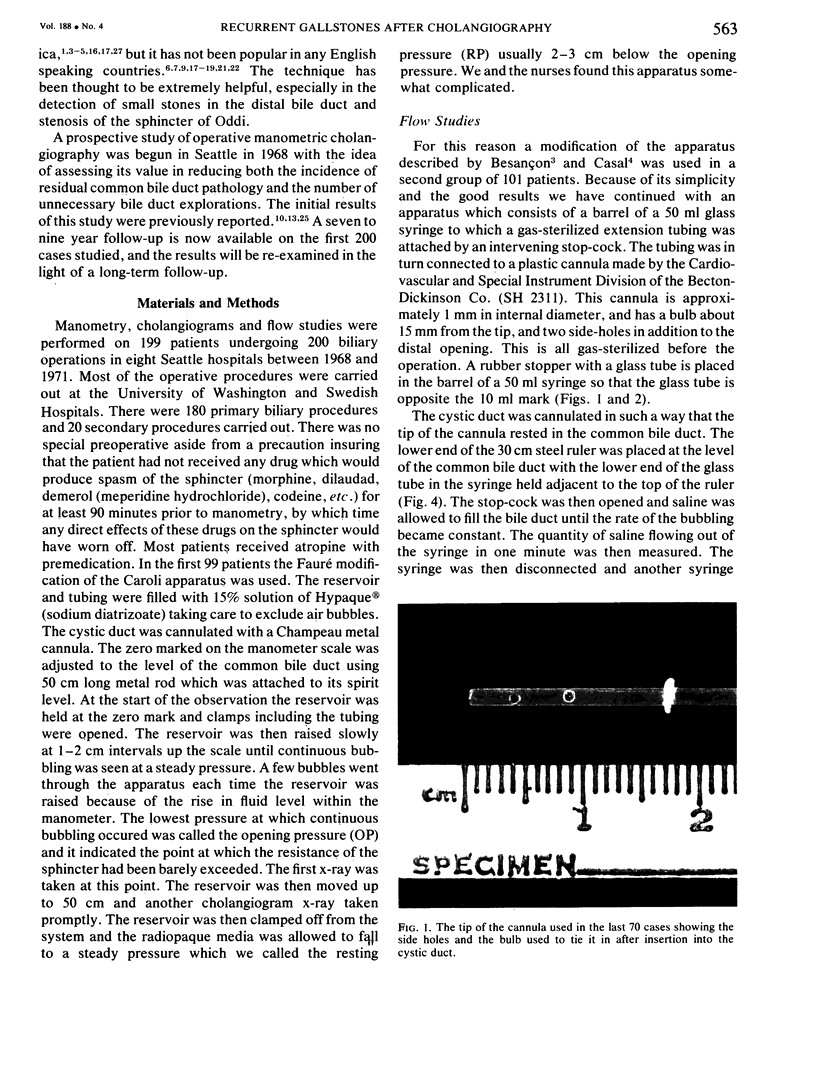
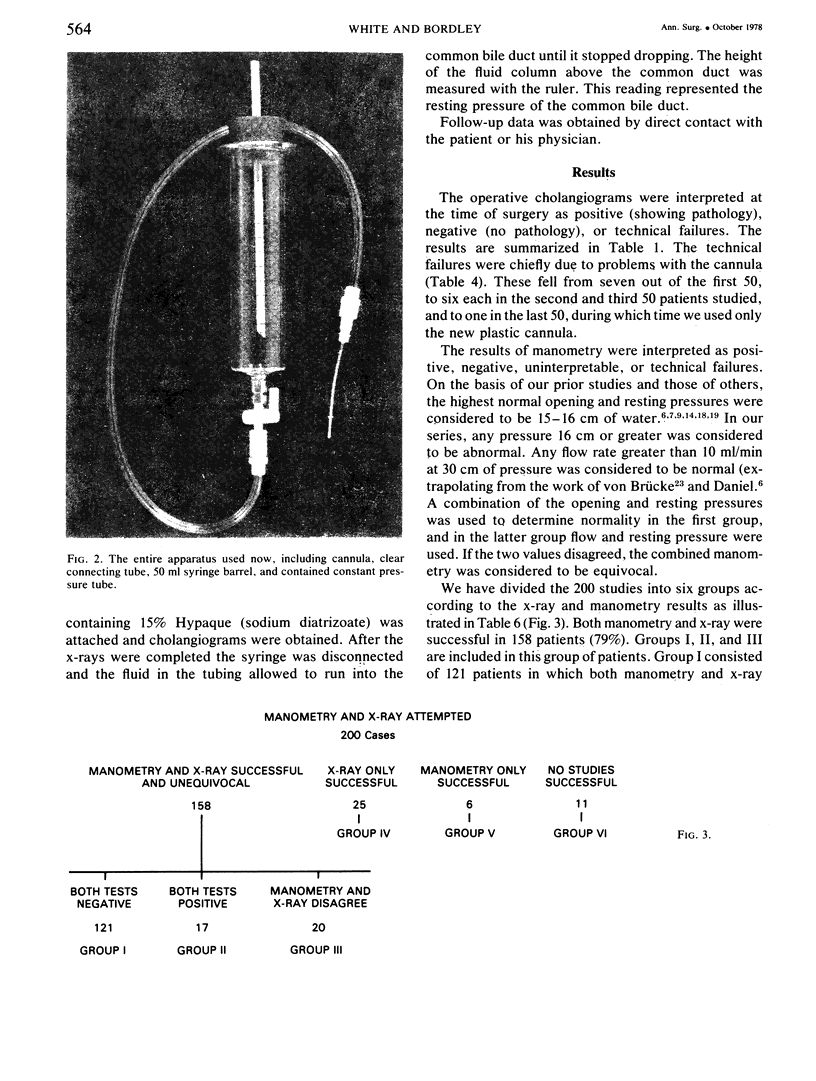
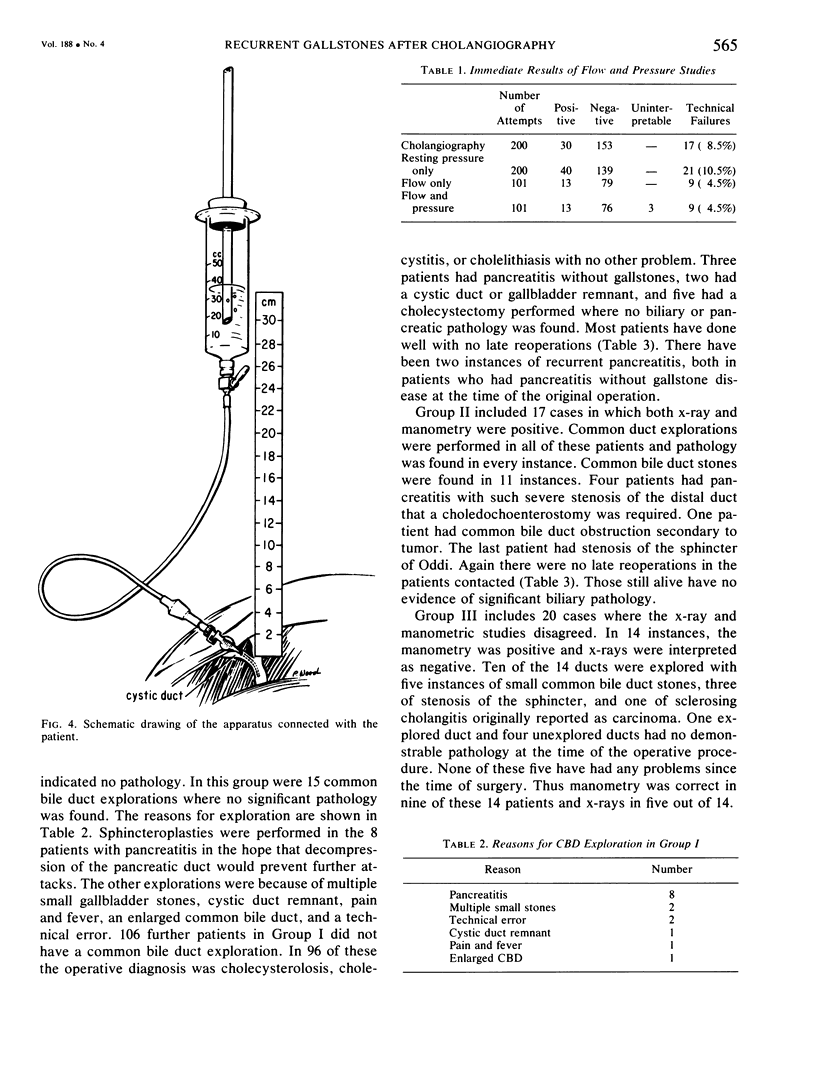
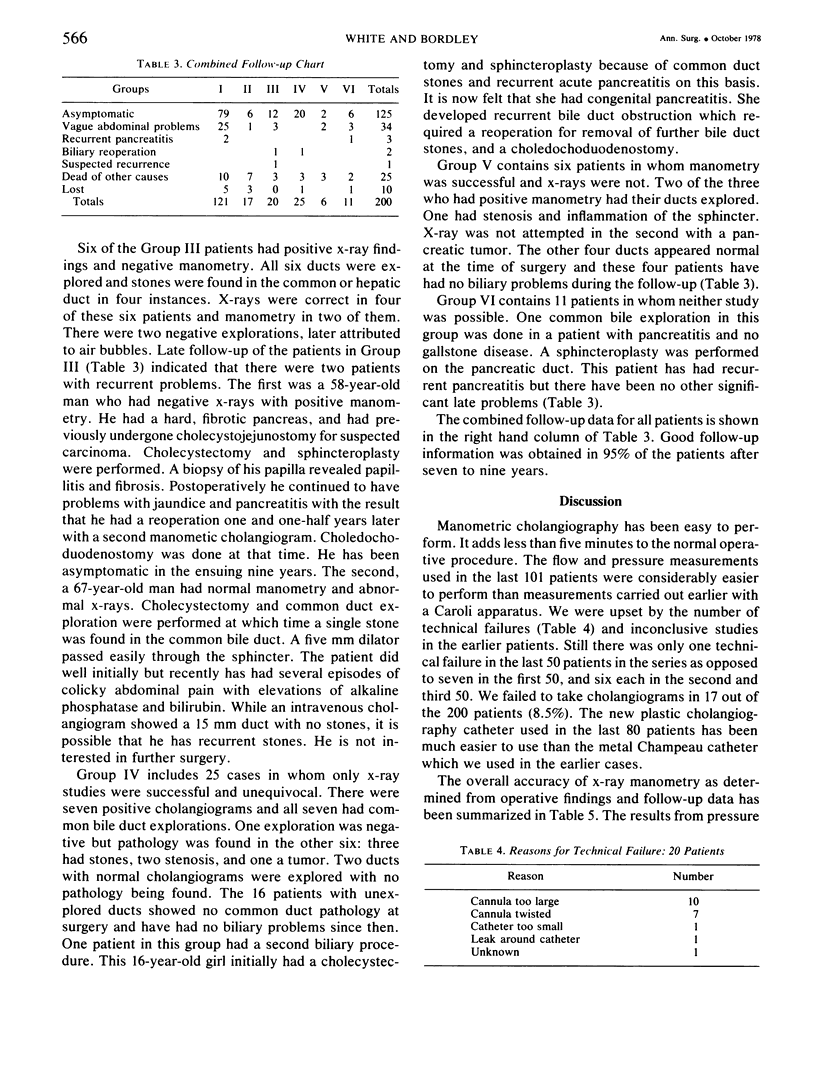
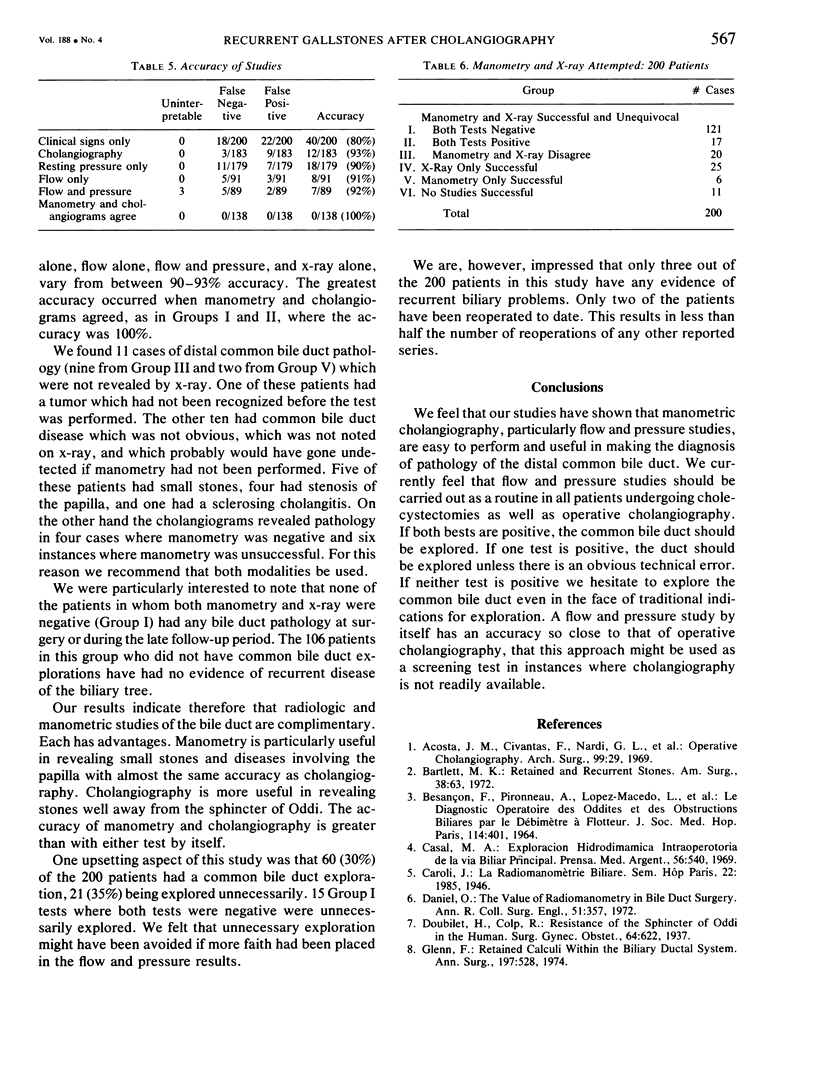

Images in this article
Selected References
These references are in PubMed. This may not be the complete list of references from this article.
- Acosta J. M., Fotheringham W. T., Ruiz L. O., Nardi G. L. Operative cholangiography. Arch Surg. 1969 Jul;99(1):29–32. doi: 10.1001/archsurg.1969.01340130031006. [DOI] [PubMed] [Google Scholar]
- Bartlett M. K. Retained and recurrent common duct stones. Am Surg. 1972 Feb;38(2):63–68. [PubMed] [Google Scholar]
- Casal M. A. Exploración hidrodinámica intraoperatoria de la vía principal. Prensa Med Argent. 1969 May 23;56(12):540–545. [PubMed] [Google Scholar]
- Daniel O. The value of radiomanometry in bile duct surgery. Ann R Coll Surg Engl. 1972 Dec;51(6):357–372. [PMC free article] [PubMed] [Google Scholar]
- Glenn F. Retained calculi within the biliary ductal system. Ann Surg. 1974 May;179(5):528–539. doi: 10.1097/00000658-197405000-00003. [DOI] [PMC free article] [PubMed] [Google Scholar]
- HUTCHINSON W. B., BLAKE T. Operative cholangiography. Surgery. 1957 Apr;41(4):605–612. [PubMed] [Google Scholar]
- Hopton D., White T. T. An evaluation of manometric operative cholangiography in 100 patients with biliary disease. Surg Gynecol Obstet. 1971 Dec;133(6):949–954. [PubMed] [Google Scholar]
- Jolly P. C., Baker J. W., Schmidt H. M., Walker J. H., Holm J. C. Operative cholangiography: a case for its routine use. Ann Surg. 1968 Sep;168(3):551–565. doi: 10.1097/00000658-196809000-00019. [DOI] [PMC free article] [PubMed] [Google Scholar]
- Kavlie H., White T. T. Flow rates and manometry in the assessment of the common bile duct. Acta Chir Scand. 1972;138(8):817–826. [PubMed] [Google Scholar]
- MALLET-GUY P., ROSE J. D. Per-operative manometry and radiology in biliary tract disorders. Br J Surg. 1956 Jul;44(183):55–68. doi: 10.1002/bjs.18004418310. [DOI] [PubMed] [Google Scholar]
- McCarthy J. D. Radiomanometric guides to common bile duct exploration. Am J Surg. 1977 Dec;134(6):697–701. doi: 10.1016/0002-9610(77)90305-1. [DOI] [PubMed] [Google Scholar]
- McCarthy J. D. Radiomanometry during biliary operations. Arch Surg. 1970 Apr;100(4):424–429. doi: 10.1001/archsurg.1970.01340220100018. [DOI] [PubMed] [Google Scholar]
- Mongé J. J. Secondary exploration of the biliary tract. Am J Surg. 1966 May;111(5):673–677. doi: 10.1016/0002-9610(66)90039-0. [DOI] [PubMed] [Google Scholar]
- Schein C. J., Beneventano T. C. Biliary manometry: its role in clinical surgery. Surgery. 1970 Feb;67(2):255–260. [PubMed] [Google Scholar]
- Way L. W., Admirand W. H., Dunphy J. E. Management of choledocholithiasis. Ann Surg. 1972 Sep;176(3):347–359. doi: 10.1097/00000658-197209000-00011. [DOI] [PMC free article] [PubMed] [Google Scholar]
- Yvergneaux J. P., Bauwens E., Yvergneaux E. Diagnostic de la sténose oddienne bénigne dans une série homogène de 1150 interventions biliaires sous radiomanométrie. Ann Chir. 1974 Jul;28(7):545–552. [PubMed] [Google Scholar]
- von Brücke H. Physikalische Messmethoden in der Gallenchirurgie. Grundlagen, Technik, klinische Bedeutung. Langenbecks Arch Chir. 1968;321(4):334–338. doi: 10.1007/BF01442315. [DOI] [PubMed] [Google Scholar]




